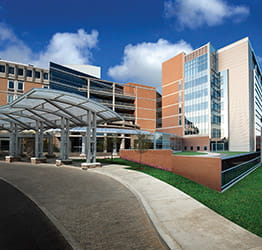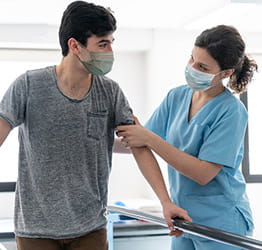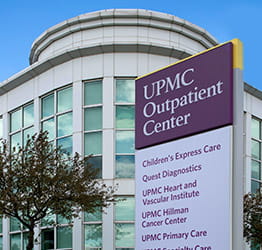On this page
What Is Breast Cancer in Men?
Breast cancer occurs when cells in the breast multiply and grow out of control, forming a tumor that can spread to surrounding tissues or other areas of the body.
Both males and females are born with breast tissue. However, breast cancer is less common in men because men have less breast tissue than women, and their breast tissue is not exposed to the growth-promoting effects of female hormones.
Although breast cancer in men is less discussed, it is still a serious condition that requires expert, personalized care.
What are the types of breast cancer in men?
Although rare, men can get the same types of breast cancer as women, including:
- Angiosarcoma — Starts in the cells that line the blood or lymph vessels.
- Ductal carcinoma in situ (DCIS) — An early-stage breast cancer that develops in the lining of the milk ducts and has not spread to other parts of the body.
- Inflammatory breast cancer — A rare, aggressive type of breast cancer that causes reddening and swelling of the breast.
- Invasive ductal carcinoma — The most common type of breast cancer, invasive ductal carcinoma accounts for 90% of breast cancer cases in men. This type of breast cancer starts in the lining of the milk ducts and may be preceded by ductal carcinoma in situ.
- Invasive lobular carcinoma — The second most common type of breast cancer, it begins in the glands that produce milk.
- Lobular carcinoma in situ (LCIS) — Starts in the glands that produce milk, called the lobules, and has not spread to other parts of the body. Although not technically considered cancer, LCIS increases your risk of developing breast cancer in the future.
- Paget’s disease of the nipple — Causes redness and irritation of the nipple on one breast. It can be mistaken for eczema or an infection.
- Phyllodes tumor — A rare tumor that develops in the connective tissue of the breast.
How common is breast cancer in men?
Breast cancer in men is rare. According to the U.S. Centers for Disease Control and Prevention (CDC), about 1% of breast cancer cases in the U.S. are diagnosed in men.
What causes breast cancer in men?
Breast cancer occurs when cells in your breast multiply and grow out of control, forming a tumor that can spread to surrounding tissues or other areas of your body.
What are breast cancer risk factors and complications in men?
Breast cancer risk factors in men
Anyone can develop breast cancer, but certain factors may increase your risk, including:
- A family history of breast cancer.
- A history of radiation exposure to the chest, such as prior cancer treatment.
- Being between 60 and 70 years of age.
- Being obese, which is linked to increased estrogen levels.
- Having the BRCA1 and BRCA2 gene mutation.
- Having Klinefelter syndrome, a condition that causes men to have an extra X chromosome and higher levels of estrogen.
- Having liver disease, which affects hormone regulation.
- Having had previous hormone therapy or estrogen exposure, such as from prostate cancer treatments.
Complications of breast cancer in men
Because breast cancer in men is rare, many men and their doctors do not suspect breast cancer until the cancer is at an advanced stage. If left untreated, breast cancer in men can spread to other areas of the body, making it more challenging to treat.
How can I prevent breast cancer in men?
There is nothing you can do to prevent breast cancer in men. Although routine breast cancer screening with mammography is not recommended for men, performing monthly breast self-exams can help men identify symptoms of breast cancer early.
Back to top
What Are the Signs and Symptoms of Breast Cancer in Men?
Breast cancer symptoms in men are the same as breast cancer symptoms in women and may include:
- A change in the size or shape of your chest.
- A dimpled, puckered, or "orange-peel" appearance of your skin.
- A lump or thickening on your chest or under your arm, which could be painless, firm, or fixed.
- A nipple that retracts (turns inward).
- Bloody or fluid discharge from your nipple.
- Red or swollen skin on your chest, nipple, or areola (the dark circle of skin around your nipple).
When should I see a doctor about my breast cancer symptoms?
If you notice symptoms of breast cancer, you should schedule an appointment with your doctor right away.
Back to top
How Do You Diagnose Breast Cancer in Men?
To diagnose breast cancer in men, your doctor will ask about your symptoms, perform a physical exam, and order imaging tests.
What to expect during your visit
If your doctor suspects breast cancer, they will:
- Ask about your symptoms.
- Ask about your family history of breast cancer.
- Perform a physical exam.
- Order imaging tests.
- Review your health history and medications.
Tests to diagnose breast cancer in men
Your doctor may order diagnostic imaging studies, including:
- 3D mammogram (tomosynthesis) — A safe, noninvasive x-ray of your breast tissue. Your doctor may use computer-aided detection (CAD) software, which highlights abnormalities in your breast tissue.
- Magnetic resonance imaging (MRI) — A safe, noninvasive imaging test that uses a magnetic field and radio waves to produce highly detailed images of breast tissue without radiation exposure.
- Ultrasound (sonography) — A painless, noninvasive test that uses high-frequency sound waves to produce real-time pictures of your breast tissue.
Your doctor may also order a minimally invasive breast biopsy, which involves using a hollow needle to take a sample of breast tissue to be tested for cancer. Your doctor will perform the biopsy using mammography, MRI, or ultrasound guidance.
Breast cancer in men prognosis
Early diagnosis of breast cancer in men improves the chances of successful treatment. However, male breast cancer is often diagnosed in its later stages due to a lack of awareness of early symptoms.
According to the American Cancer Society, when breast cancer in men is diagnosed before it spreads beyond the breast, 95% of men live for at least five more years. When breast cancer has spread to other parts of the body, the five-year survival rate drops to 20%.
Your prognosis after a breast cancer diagnosis will depend on your overall health, as well as the type and stage of your breast cancer. Your doctor will discuss your expected prognosis with you.
Back to top
How Do You Treat Breast Cancer in Men?
The goals of breast cancer treatment in men are to remove the tumor, reduce the risk that the cancer will spread to other parts of your body, and lower the chances of recurrence after treatment.
Your care team will develop a comprehensive treatment plan that may include:
Surgery for breast cancer in men
Surgery is often the primary treatment for breast cancer in men and women.
If you are diagnosed with breast cancer or another type of benign breast tumor, your doctor may recommend:
- Lumpectomy — Also known as breast-conserving surgery or partial mastectomy, a lumpectomy is a surgical procedure to remove the part of your breast with a cancerous tumor and some healthy surrounding tissue.
- Mastectomy — A surgical procedure to remove the entire breast. When both breasts are removed, it is known as a double mastectomy.
Your doctor may recommend surgery to remove and test your lymph nodes to determine whether your breast cancer has spread.
Lymph node procedures include:
- Axillary lymph node dissection — Surgery to remove all or a group of lymph nodes in the axilla (armpit), if your sentinel lymph node biopsy is positive for cancer.
- Sentinel lymph node biopsy — A minimally invasive procedure to remove the sentinel (main) lymph node in the axilla (armpit) to test it for cancer. It is performed to determine if cancer has spread to your lymph nodes.
Medical oncology for breast cancer in men
Medical oncology for breast cancer involves using different types of anti-cancer medications to slow or stop breast cancer growth. Medical oncology treatments may include:
- Chemotherapy — Uses medications that travel through your bloodstream to kill cancer cells throughout your body.
- Hormone therapy — Slows or stops cancer growth by preventing hormones from attaching to the breast cancer cells.
- Immunotherapy — Uses medications to boost your immune system’s ability to identify and kill cancer cells.
- Targeted therapy — Works similarly to antibodies produced naturally by your immune system to identify and attack cancer cells.
Medical oncology treatment may be administered before or after surgery, or as a long-term treatment to reduce the risk of cancer recurrence.
Radiation oncology for breast cancer in men
Radiation oncology is a medical specialty that uses radiation therapy to kill cancer cells. Radiation therapy for breast cancer involves using high-energy x-rays to precisely target your tumor. It may be used alone or in combination with other treatments to effectively treat breast cancer.
Radiation oncology treatment options for breast cancer include:
- Accelerated partial breast radiation — Delivers radiation to only the area surrounding the tumor, where breast cancer is most likely to recur. Types of accelerated partial breast radiation include intracavitary breast radiation, MammoSite®, Contura®, and Savi®.
- Balloon breast brachytherapy — A type of internal radiation therapy (high-dose rate brachytherapy) that is used after a lumpectomy. The treatment involves using a radioactive seed to deliver radiation directly to the tumor.
- External beam radiation — Special machines administer a high dose of radiation directly to the cancer site. Types of external beam radiation include image-guided radiation therapy (IGRT) and intensity-modulated radiation therapy (IMRT).
- Hypofractionated (short-course) breast radiation — Delivers radiation in a four-week course, instead of a six-week course for select patients.
Back to top
Why Choose UPMC for Breast Cancer Care in Men?
When you choose UPMC for breast cancer care in men, you will receive:
- Comprehensive breast cancer expertise — The breast cancer experts at UPMC provide state-of-the-art care for every form of breast cancer at every stage of the disease.
- Personalized, collaborative care — Our surgical, medical, and radiation oncologists work together to plan the best course of therapy for you.
- Supportive services tailored to your needs — Our approach to breast cancer care honors your preferences by blending advanced clinical methods with supportive services for the best possible results.
Back to top
By UPMC Editorial Staff. Last reviewed on 2025-09-18.
















